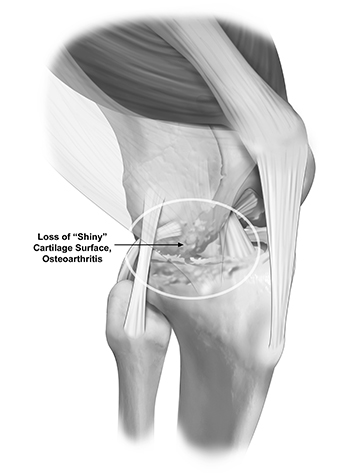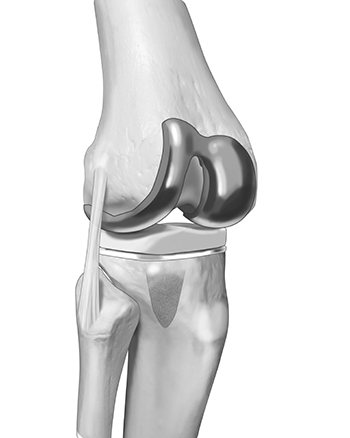Knee
- Knee Osteoarthritis
- Knee Osteoarthritis Non-Surgical Treatment
- Knee Osteoarthritis Surgical Treatment
- Patient Resources
Knee Osteoarthritis
What is knee osteoarthritis?
Types of Arthritis Affecting the Knee
There are three main types of arthritis that can affect the knee: osteoarthritis, inflammatory arthritis, and post-traumatic arthritis. Among these, osteoarthritis (OA) is the most common. Knee OA can significantly impact daily activities such as kneeling, climbing stairs, and even walking.
Prevalence and Impact
Osteoarthritis affects over 50 million adults in the United States and is the most prevalent musculoskeletal disease. Globally, approximately 3% of the population, or about 200 million people, are affected by knee OA. It accounts for up to 18% of all healthcare visits and is often associated with other health conditions, including depression, diabetes, obesity, and heart disease.
Economically, OA is a major contributor to work loss, costing the U.S. roughly $100 billion per year, which is double the healthcare costs associated with chronic heart and lung disease.
Risk Factors
OA is primarily a disease of aging, generally affecting people over the age of 50. It can run in families, and women are affected more often than men. Excess weight places additional stress on the knee joint, with each extra pound adding 3–4 pounds of force on the knees.
Other factors that increase the risk of OA include:
Knee malalignment, such as bow-leggedness or knock-knees
Repetitive joint stress, whether from work, sports, or athletic activities
Previous traumatic injuries, which can lead to post-traumatic OA
Understanding these risk factors can help guide prevention strategies and inform treatment decisions for maintaining long-term knee health.
What causes knee osteoarthritis?
Osteoarthritis (OA) is a chronic, progressive, degenerative disease. It is often called “wear and tear” arthritis because it is the slow deterioration of cartilage, causing the bones to rub against each other. It can affect the shin bone (tibia), the thighbone (femur), and the kneecap (patella).
It is estimated that 85 percent of osteoarthritis originates from changes that are part of the normal aging process (just like gray hairs and wrinkles). The remainder occurs from post-traumatic osteoarthritis (PTOA), which occurs after a knee injury such as an ACL tear or meniscus injury that predisposes the knee to future joint degeneration. It is important to differentiate osteoarthritis (wear and tear changes of the joint) from inflammatory conditions like rheumatoid arthritis, which is an autoimmune disease (where your body attacks its own joints). In autoimmune diseases, the immune system malfunctions and attacks the body instead of intruders. In the case of rheumatoid arthritis, it attacks the synovial membrane that encases and protects the joints, often affecting several joints at one time.
What are the symptoms of knee osteoarthritis?
Cartilage does not have nerves and therefore does not cause pain when damaged. However, irritation of the bone beneath the cartilage or the lining of the joint (synovium) that results from cartilage loss can cause pain. Some people have significant OA, but they might not have pain. Common symptoms of knee arthritis include:
- Joint Pain: Knee osteoarthritis typically causes pain in the knee joint. The pain is typically a dull ache felt on either side of the knee or in the front of the knee. The pain often worsens with activity and improves with rest.
- Stiffness: People with knee OA may experience stiffness in the knee joint, making it difficult to move the knee through its full range of motion.
- Reduced Range of Motion: As the condition progresses, the range of motion in the knee joint may become limited, making it challenging to perform activities like walking, bending, or climbing stairs.
- Crepitus: Some people with knee OA may notice a grinding or grating sensation in the knee joint, which is known as crepitus.
- Decreased Function: Knee osteoarthritis can affect a person’s ability to perform daily activities and participate in physical activities.
- Muscle Weakness: The muscles around the knee joint may become weakened due to pain and reduced activity.
- Bone Spurs: Over time, the body may respond to the damage in the joint by forming bony growths or bone spurs at the edges of the joint.
How is knee osteoarthritis diagnosed?
Physical Exam
A comprehensive physical exam will be conducted to assess the range of motion in your knee joint, look for signs of inflammation or swelling, and feel for areas of tenderness or crepitus (grating or grinding sensations). Your gait (the way you walk) will also be evaluated to identify any abnormalities.
Imaging
Diagnostic imaging is necessary to definitively diagnose knee osteoarthritis. X-rays will reveal joint space narrowing, the presence of bone spurs, and the extent of cartilage damage.
Knee Osteoarthritis Non-Surgical Treatment
Some people lead active lives without ever knowing they have knee osteoarthritis, often experiencing no pain. When symptoms of knee arthritis do develop, patients can choose to either treat the symptoms alone or address both the symptoms and the underlying joint structure. Conservative treatment focuses on relieving only the symptoms of knee arthritis.
Non-surgical treatment options for knee osteoarthritis include:
Activity modification: Avoiding movements or exercises that trigger knee pain, and taking breaks from aggravating activities.
Medications: Over-the-counter anti-inflammatory medications can help reduce pain and inflammation.
Physical therapy: Exercises to improve strength, flexibility, and knee function.
Injections: Corticosteroid injections, hyaluronic acid (gel injections), or PRP (platelet-rich plasma) may provide additional relief.
With proper conservative care, symptoms often improve within several weeks. If knee pain is resolved and patients can return to their desired level of activity, joint replacement surgery is not necessary.
Knee Osteoarthritis Surgical Treatment
What are the surgical options for knee osteoarthritis?
When nonsurgical knee arthritis treatments do not relieve knee pain and imaging confirms knee osteoarthritis, it is reasonable to consider the more definitive treatment option of surgery. Surgery for knee osteoarthritis is a knee replacement surgery, otherwise known as a partial or total knee arthroplasty. A joint replacement surgeon will need to be consulted to further discuss a knee replacement.


Since Dr. Penalosa does not perform knee replacements, he can provide a referral to a trusted joint replacement surgeon who performs over 1,000 knee replacements per year. During your consultation with a joint replacement surgeon, you will learn more about the surgical procedure, rehabilitation process, and recovery timeline. You will also have the opportunity to ask any questions or address concerns regarding knee replacement surgery.
It is essential to seek medical attention if you suspect knee osteoarthritis or are experiencing knee pain and reduced mobility. Early diagnosis and proper management can improve your quality of life and prevent the condition from worsening. A joint replacement surgeon referred by Dr. Penalosa will work with you to develop a personalized treatment plan tailored to your specific needs.
Patient Resources
Orthopedic surgeon Dr. Bryan Penalosa and his team are dedicated to providing an industry-leading patient experience—one that is smooth, efficient, and convenient. Our team has compiled a comprehensive set of orthopedic patient resources to assist you with insurance information, patient forms, and much more.
Explore the patient resources below to learn more.
- Preparing for Surgery
- Traveling for Surgery
- Pre-Operative Clearance
- Peri-Operative Nutrition
- Post-Operative Instructions
- Post-Operative Physical Therapy
- Post-Operative Medications
- Durable Medical Equipment
- Billing & Insurance
- Patient Portal
- Medical Records
- Patient IQ
- Clinical Case and Imaging Review
- Ongoing Clinical Trials
- Sports Performance Center
